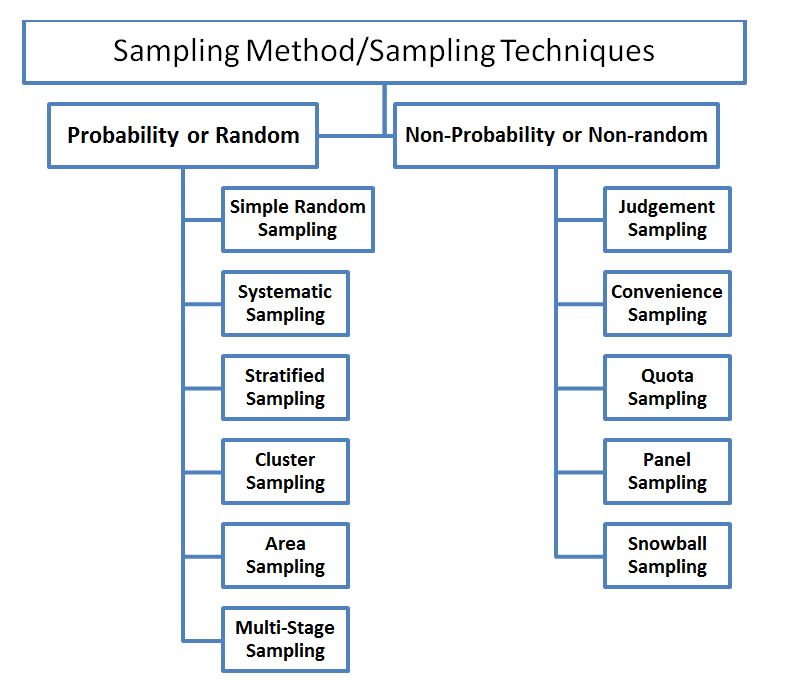Sampling methods can be categorised into two types of sampling:
Probability Sampling – In this sampling method the probability of each item in the universe to get selected for research is the same. Hence the sample collected through this method is totally random in nature. Therefore it is also known as Random Sampling.
Non-Probability Sampling – In this sampling method the probability of each item in the universe to get selected for research is not the same. Hence the sample collected through method is not random in nature. Therefore it is known as Non-random Sampling.
Sampling Methods/Sampling Techniques

Probability or Random Sampling Methods:
(1) Simple random sampling – This method simply involves the task selecting sampling units randomly out of the sampling frame. A researcher may use the following methods for selecting random samples – Lottery Method, Random Numbers, software etc.
There are two types of random sampling:
- SRSWR – Simple random sampling with replacement
- SRSWOR – Simple random sampling without replacement
(2) Stratified sampling – In this method a heterogeneous population is divided into different small sub-units, which are called stratas. These stratas are homogenous among themselves with respect to a certain factor or characteristic. Items or sampling units are randomly selected from these stratas that together make up the sample.
(3) Systematic sampling – In this type of sampling the first unit is selected randomly and then every Kth item on the source list is selected, which becomes the part of the sample. The value of K is determined by :
K = Total no. of units in population/No. of units in sample
The essence of this method is selection of random items from the source list at a specified interval from the selected unit, hence forming a system for selecting items. The Items may be arranged numerically, alphabetically or in an increasing or decreasing order and then a formula is applied to it.
(4) Cluster sampling – This method is used where the size of population is very large. In this method a homogeneous population is divided into smaller heterogeneous groups and then samples are drawn out at random from these heterogeneous groups. These heterogeneous groups are called clusters. All items belonging to the selected heterogeneous groups become the part of the sample.
(5) Area Sampling – If the clusters are divided on geographical basis, it is termed as area sampling.
(6) Multi-stage sampling – In multistage sampling, sampling is performed at more than 1 step or stage. At first stage units are selected by some random sampling method usually SRSWOR or Systematic sampling and at the second stage again some units are selected out of the previously selected units through some suitable method. It can be understood as an expansion of the cluster sampling method where instead of selecting the entire heterogeneous group, items are drawn randomly from each heterogeneous group to form a sample.
Non-Probability or Non-Random Sampling Methods
(1) Judgement sampling – In this method, the sampling units are chosen by the researcher on the basis of his or her own judgement. The research simply selects the sample which in his opinion will be best for the study.
(2) Quota sampling – In this method of sampling, quotas in form of reservation or percentage are established for different classes of population on the basis of age, gender, nationality etc. A sample is then drawn out on the basis of these quotas.
(3) Panel sampling – In this method regular surveys are taken by a researcher from a panel of experts of a particular domain through questionnaires or schedules. The panelists may or may not know about other during the research process.
(4) Convenience sampling – In convenience sampling, a researcher simply selects the sample and sampling units that are easily available and accessible. No extra efforts are taken by the researcher as he simply chooses the samples on the basis of convenience.
(5) Snowball sampling – This method is used in cases where the population to be studied is rare, therefore it is difficult to find good representative sampling units. In this method the researcher initially selects a sampling unit (a doctor, a musician, a cancer patient depending upon the study) based on his judgement and then starts taking further samples on the basis of directions/advice/referral provided by the first sampling unit.
The researcher starts by interviewing one person or small group of people and then asks them for references. He then collects data from the suggested people and asks them for references and the chain continues until an adequate sample is formed.